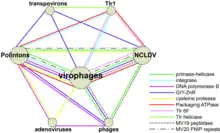| Bamfordvirae | |
|---|---|
| Virus classification | |
| (unranked): | Virus |
| Realm: | Varidnaviria |
| Kingdom: | Bamfordvirae |
| Subtaxa | |

The genetic network linking various types of Bamfordvirae viruses and selfish genetic elements, represented by labeled circles. Links between circles are color-coded by the gene whose sequence homology establishes the link.[1]
Bamfordvirae is a kingdom of viruses.[2] This kingdom is recognized for its use of double jelly roll major capsid proteins.[3] It was formerly known as the PRD1-adenovirus lineage.[4] The kingdom is named after Dennis H. Bamford who first promoted the evolutionary unity of all viruses encoding double jelly-roll major capsid proteins.[5][6][4]
Taxonomy
The following phyla are recognized:
References
- ↑ Yutin, Natalya; Raoult, Didier; Koonin, Eugene V (2013). "Virophages, polintons, and transpovirons: a complex evolutionary network of diverse selfish genetic elements with different reproduction strategies". Virology Journal. 10 (1): 158. doi:10.1186/1743-422X-10-158. PMC 3671162. PMID 23701946.
- ↑ "Virus Taxonomy: 2019 Release". talk.ictvonline.org. International Committee on Taxonomy of Viruses. Retrieved 25 April 2020.
- ↑ Koonin EV, Dolja VV, Krupovic M, Varsani A, Wolf YI, Yutin N, Zerbini M, Kuhn JH (October 2019). "Create a megataxonomic framework, filling all principal taxonomic ranks, for DNA viruses encoding vertical jelly roll-type major capsid proteins". ICTV Proposal (Taxoprop): 2019.003G. doi:10.13140/RG.2.2.14886.47684.
- 1 2 Krupovič, Mart; Bamford, Dennis H. (December 2008). "Virus evolution: how far does the double β-barrel viral lineage extend?". Nature Reviews Microbiology. 6 (12): 941–948. doi:10.1038/nrmicro2033. PMID 19008892. S2CID 31542714.
- ↑ Bamford, DH; Burnett, RM; Stuart, DI (2002). "Evolution of viral structure". Theoretical Population Biology. 61 (4): 461–70. doi:10.1006/tpbi.2002.1591. PMID 12167365.
- ↑ Bamford, DH (2003). "Do viruses form lineages across different domains of life?". Research in Microbiology. 154 (4): 231–6. doi:10.1016/S0923-2508(03)00065-2. PMID 12798226.
This article is issued from Wikipedia. The text is licensed under Creative Commons - Attribution - Sharealike. Additional terms may apply for the media files.